
views
Taking Notes
Annotate the text as you read. Annotating as you read will help you find important passages easily while you are writing the summary. Circle, highlight, or note anything that’s confusing, important, surprising, or interesting. You can also mark repetition, inconsistencies, and connections between passages. If the book belongs to you, feel free to highlight passages and write in it. If the book doesn’t belong to you, use sticky notes to mark the passages instead.

Write notes while you’re reading. Keep a notebook next to you while you read so you can jot down your thoughts. Taking notes as you read will allow you to record things correctly. This will create less work for you than if you try to go back and check on details later. It might be a good idea to keep several different pieces of paper next to you for notes. One can be for general impressions and quick thoughts, another can be for lists of characters and events, and one more for recording the book’s major themes and ideas. You can also take notes to keep track of words you don’t recognize. Use a dictionary to look these up as you go, and then write down the definitions.
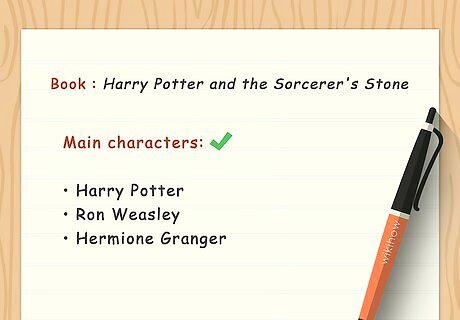
Keep a running list of the main characters. Write down the main characters’ names and a brief description of their personalities or major characteristics. Include a line or two about each of the main characters’ desires and goals. Use these notes to think about how the characters illustrate the main themes of the book. You can also make a timeline of the major events that occur in the book, especially if the chronology is complicated or confusing. Keep multiple timelines if the story jumps back and forth between different plotlines.
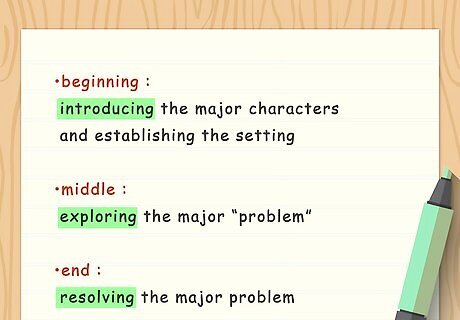
Break the book down into sections. To keep yourself from getting overwhelmed, think about the book in three parts. The story will have a beginning, middle, and end. Organize your notes based on these sections. The beginning will be focused on introducing the major characters and establishing the setting of the story. The middle will explore the major “problem” of the book, whether it’s a fight between good and evil or a murder mystery. The end will resolve the book’s major problem.
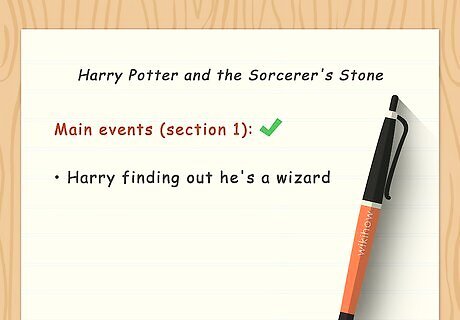
Identify the main point of each section. Each section should have a specific theme and purpose. Think about what the author spends the most time on in each section. Be sure to also consider how the sections relate to one another.
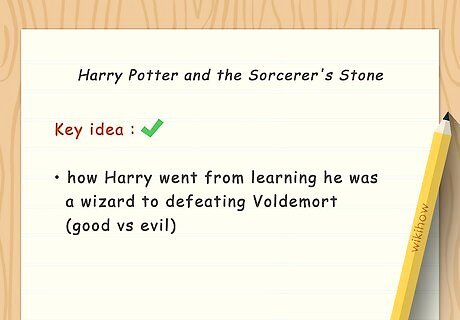
Determine the book’s one key idea. As you’re reading, think about what lesson the book is trying to teach. Notice what theme comes up again and again. It might be something that the characters always talk about, or a fatal flaw in people that causes problem after problem. For example, the author may want to show readers that pride leads people to make bad decisions. To demonstrate this, the main character keeps getting themselves into situations that are above their head because they’re prideful and arrogant. If you’re reading a nonfiction book, the main idea might be something about history or society. Maybe the author wants to show readers that fast food is unhealthy, and the book brings up lots of examples to prove that point.
Drafting and Editing

Check if there are length requirements for your summary. If you’re writing your summary for a school assignment, there will probably be a limit to how much or little you can write. Make your summary as close to that limit as possible. Too short will make it seem like you didn’t read the book, and too long could mean that you’re not really writing a summary. For example, if your word limit is 200, write between about 190 and 200 words. Even if you’re writing a summary for your own use, consider keeping it on the short side. Having a summary under 500 words gives you a quick and easy reference tool.
Write the summary in chronological order. A summary should present the events in the sequence that they happened. Avoid jumping around between different parts of the book. Begin at the beginning and end at the ending to maintain the integrity of the original story.
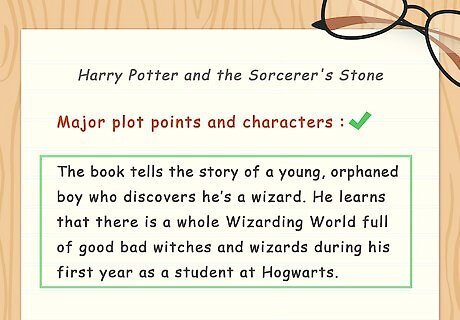
Describe the major plot points and characters. Start by introducing the title and author of the book and then briefly describe what happened in the book. This should only take a few sentences. Think of it as your introduction. You could say something like: “J.K. Rowling’s Harry Potter and the Sorcerer’s Stone tells the story of a young, orphaned boy who discovers he’s a wizard. He learns that there is a whole Wizarding World full of good bad witches and wizards during his first year as a student at Hogwarts.”
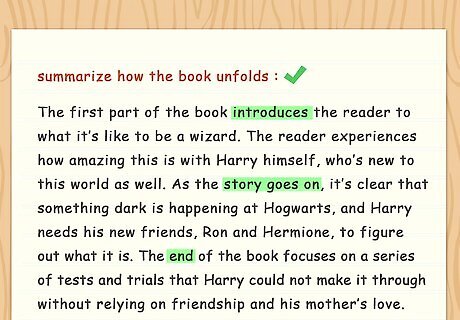
Explain the main points of the book’s sections. Use your notes to summarize how the book unfolds. Spend a few sentences explaining what happens in each section, how they build on each other, and why the section is important to the overall point of the book. This part of the summary might look like: “The first part of the book introduces the reader to what it’s like to be a wizard. The reader experiences how amazing this is with Harry himself, who’s new to this world as well. As the story goes on, it’s clear that something dark is happening at Hogwarts, and Harry needs his new friends, Ron and Hermione, to figure out what it is. The end of the book focuses on a series of tests and trials that Harry could not make it through without relying on friendship and his mother’s love.”
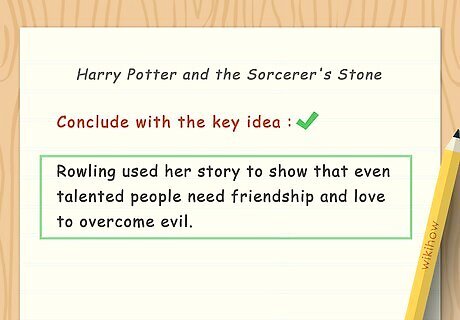
Conclude by stating the book’s key idea. Finish your summary by stating what you feel is the lesson of the book. Refer back to your notes to remind yourself what theme came up again and again. This statement should be the last sentence of the summary. For example: “Rowling used her story to show that even talented people need friendship and love to overcome evil.” Simple steps for a clear, concise summary. "I used to be terrible at summarizing books — I'd always include way too many details. But this article gave me an easy formula to identify key points, themes, and write a solid draft. Now, prepping summaries is a total breeze." - Emmanuel M. Clarified how to pinpoint main arguments. "I'd get overwhelmed trying to pick out the most important ideas when summarizing. The tips on tracking central themes and lessons helped me zero in on an author's main points. Now, I can capture the core arguments in a clear, concise way." - Myrtha S. Killer tricks that fixed my frustrating summarizing issues. "Summarizing was my weak spot for assignments and exams, and it used to cause me a ton of trouble. But learning new annotation strategies and how to draft concisely was a game changer. Writing summaries is quick and painless now!" - Manzi D. The perfect starting guide for my first book report. "I was super anxious about effectively summing up all the key details for an upcoming book report. But this step-by-step guide taught me how to take notes and identify critical plot points methodically. Now I feel ready to nail this summary!" - Philip David A. Notes and close reads are key to summarizing well. "I used to skim through books and overlook important details. But this emphasized taking thorough notes and reading closely. Putting those habits into practice has already improved how well I recall those finer points." - Sarah M. We want to hear from you! Advice from our readers makes our articles better. If you have a story you’d like to share, tell us here.
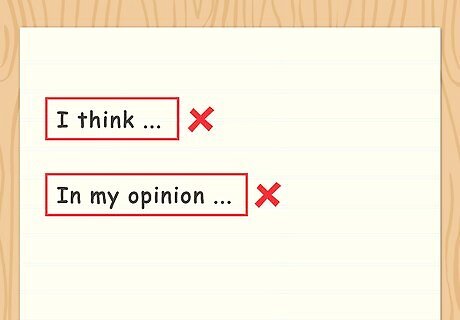
Don’t include your opinion in the summary. The summary should be a neutral description of the book. Focus on the facts of the story. Don’t write about how the book makes you feel, or whether you agree or disagree with the author. For instance, you could say, “Both Professor Quirrell and Lord Voldemort disappear after failing to obtain the Sorcerer’s Stone,” instead of, “It really sucks that Voldemort escapes because he is the worst and the author should have made sure he was captured.”
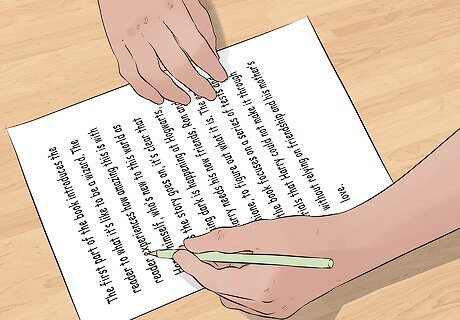
Proofread to check for mistakes. Make sure you’ve spelled everything correctly. Read the summary out loud to find grammatical errors or misplaced commas. Double check your word count. Don’t rely on spell-check, as it can’t account for context and won’t catch grammatical errors like misuse of “there,” “their,” and “they’re.” You may be writing your summary for a book club or your own use. While editing isn’t as big a deal in these cases, you’ll still want your summary to make sense. Give it a quick read-over to make sure it’s clearly written.

Share your work with a buddy. Especially if this is for school, it’s a great idea to have a friend or family member read over your work. They’ll catch any mistakes you’ve missed. If you ask a fellow student, you can exchange summaries to help each other out!
Reading Carefully

Find a quiet place to read without distractions. Pick a spot away from the TV. Turn your phone on silent and put it aside so it doesn’t tempt you. Focus just on the book, and enjoy the time you’re about to spend reading. You should also make sure you’re near a lamp or a window so you don’t strain your eyes while reading.
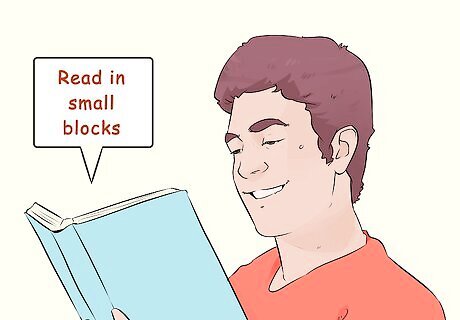
Read the book in small blocks. To keep yourself from getting overwhelmed, read in 20-minute sessions. If you really enjoy the book, you can read for an hour or two at a time. This will allow you to process the book slowly.

Set aside enough time if you’re on a deadline. You don’t want to stay up all night trying to read the book and write the summary all at once. Plan to take at least two weeks for shorter books and about a month for longer books. Take a little time every day to read. If this is for a school assignment or book club, start reading as soon as the book is assigned. Your teacher or group leader has probably calculated the exact number of weeks you’ll need to finish the book and write the summary without stressing out over it.

Re-read important passages. Important passages should be easy to spot. If you notice that a main character is having a major realization or there’s a sudden plot twist, re-read those paragraphs in the book. These passages usually won’t be focused on description. Instead, they’ll cover a turning point in the plot, a tragic event, or the resolution of some conflict.

Pay careful attention to the main characters. The main characters will be the ones whose actions, mistakes, and feelings tell you the key points of the book. Read especially carefully when they come up in the text.

Don’t get distracted by small details. When you’re writing a summary, you aren’t supposed to include little details about secondary characters, descriptions, or minor plot points. While you should still read these parts of the book and pay attention to them, they generally don’t have a central role in a summary.


















Comments
0 comment